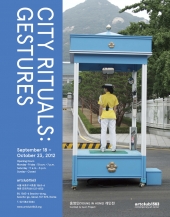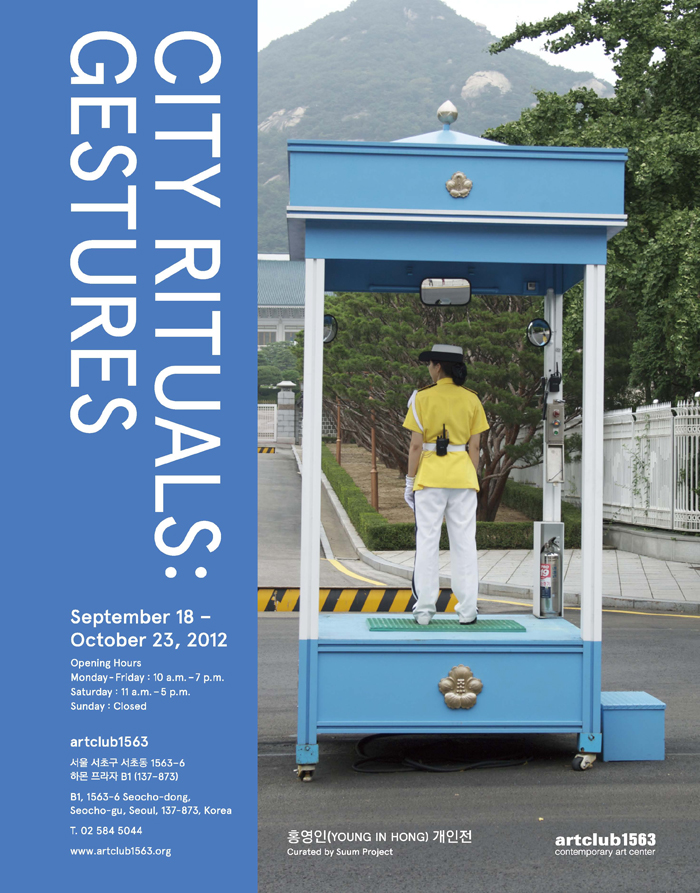상세정보
CITY RITUALS : GESTURES
September 18 - October 23, 2012
홍영인 Young In Hong
도시의 리츄얼: 제스츄어
홍영인의 개인전, ‘도시의 리츄얼: 제스츄어’는 물리적, 개념적으로 도시공간과 전시공간 사이에서 발생한다 - 기존의 아트클럽 1563 간판이 가려지면서 의미를 알 수 없는 형상의 네온 간판이 공간 입구에 걸리고, 전시 공간 내부에는 경찰 초소와 그라피티 벽이 세워진다 - 이는 우리가 도시공간을 살면서 경험하는 반복적이고 의식적인 패턴이 미술적 경험과 교차하고 겹쳐지는 지점을 드러내는 하나의 시도이다.
갤러리의 내-외부에 설치 된 작품들은 공공 장소와 개개인이 사회-정치적으로 다중적일 수밖에 없는 사실을 다룬다. 이를테면 본래 치안의 업무를 담당하는 경찰이 갤러리 공간으로 초대되어 미술 관객을 만나면서 본연의 직책, 의무가 이중적이 되는 모순상황을 일으킴과 동시에 두 시스템의 친밀한 교감이 이루어 지게 된다.
나아가 작가는 시민들의 집단적 기대, 희망이나 신념들이 도시공간 안에서 어떻게 반복적 패턴으로 시각화 되는지에 주목하고 있다. 강력한 법에 의해 제지를 당하는 서울시의 그라피티들을 모아 수를 놓은 캔버스 구조물 작업은, 이미지들이 아름다운 거리 장식으로서의 기능을 하게 되거나 혹은 시민들의 즉각적인 불만이나 기대를 골목 구석이나 화장실 벽에 갈겨쓰는 문구로 발견되는 등 집단이나 사회에 의해 공유되는 믿음에 근거하여 가능한 행동양식들로 표현되고 있다.
심리학에서 의식행동은 불안감을 줄이거나 없애기 위해 기계적으로 반복하는 행동양식으로 주체의 집요하고 충동적인 무질서 상태가 표면적으로 드러나는 증상으로 본다. 그 관점에서 도시공간에서 발견되는 의례적이고 반복적인 행동양식과 그것의 시각화는 일종의 집단적 동의의 표시이기도 하지만 역설적으로는 집단적 방어기제 혹은 언어로 설명 될 수 없는 심리적 공간으로 이해 될 수 있을 것이다. 이러한 반복적인 도시의 리츄얼을 미술적 단어로 전환함으로써, 현대도시에의 실제 경험이 공간의 ‘시간적’ 단면에 대한 이해가 없이 온전히 이해 될 수 없는 순간들을 한 자리에 모으고 있다.
City Rituals: Gestures
Young In Hong’s solo exhibition, City Rituals: Gestures, is conceptually and physically occupying the gap between city space and gallery space – Police Post is built inside the gallery, the graffiti wall is erected there while outside the ‘Artclub 1563’ sign is covered. Instead of the gallery sign, a neon light of an indecipherable image is installed at the entrance of the gallery. Together these pieces suggest a situation where our perception of aesthetics and our perception of ‘ritual patterns’ in public space overlap and entwine.
The new works introduced for this show, situated at both the interior and the exterior space of Artclub 1563, explore the multiple identities given to public space and city dwellers within the socio-politically complex modern city of Seoul. For instance, when police is invited into the gallery space to meet art audience, their duty and role becomes double, they are both part of a work of art and fulfilling their function as police officer by guarding the space and communicating with an audience. On the one hand this doubling might seem absurd but on the other hand it also includes the audience as participators in the artwork. For this exhibition the artist focuses on repetitive patterns that reflect possible collective expectations of the public, or collectively held wishes and believes of city dwellers. Thus each work deals with specific ritual patterns normally performed by different subcultural groups, based on those individual groups’ believes or values. For instance, graffiti is strictly prohibited in Seoul City. As a consequence, graffiti can be a forbidden beauty when it manifests as decorative imagery or it can be forbidden subjective utterances when it manifests as scribbled messages on the walls of back streets or toilets. If we consider that, in psychological terms, the word ‘ritual’ describes the repetitive behaviour systematically used by a person to neutralise or prevent anxiety; it can in this sense represent symptoms of the obsessive–compulsive disorder of a subject. The repetitive patterns of city rituals can then paradoxically be thought both in relation to actions confirming consensus among a majority or a marginal group as well as the pathological defence-mechanisms of individuals. City space and our psycho-physical states form an indivisible set of conditions. The space of the city is an experiential rather than an objective space. By transforming the repetitive patterns and signs of city rituals (such as scribbled graffiti, the act of providing security, purchasing flowers, or neon signs), into aesthetic vocabularies, this exhibition brings together the elements of different languages to create a situation where the experience an audience has of urban society cannot be comprehended anew without taking into account the complexity of the various temporal layers of contemporary city space.


